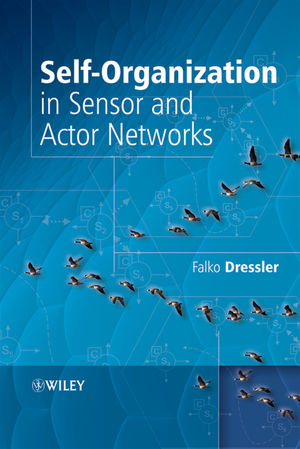Self-Organization in Sensor and Actor NetworksISBN: 978-0-470-02820-9
Hardcover
386 pages
December 2007
 |
||||||
Preface.
About the Author.
List of Abbreviations.
I Self-Organization.
1 Introduction to Self-Organization.
1.1 Understanding self-organization.
1.2 Application scenarios for self-organization.
2 System Management and Control – A Historical Overview.
2.1 System architecture.
2.2 Management and control.
2.2.1 Centralized control.
2.2.2 Distributed systems.
2.2.3 Self-organizing systems.
3 Self-Organization – Context and Capabilities.
3.1 Complex systems.
3.2 Self-organization and emergence.
3.3 Systems lacking self-organization.
3.3.1 External control.
3.3.2 Blueprints and templates.
3.4 Self-X capabilities.
3.5 Consequences of emergent properties.
3.6 Operating self-organizing systems.
3.6.1 Asimov’s Laws of Robotics.
3.6.2 Attractors.
3.7 Limitations of self-organization.
4 Natural Self-Organization.
4.1 Development of understandings.
4.2 Examples in natural sciences.
4.2.1 Biology.
4.2.2 Chemistry.
4.3 Differentiation self-organization and bio-inspired.
4.3.1 Exploring bio-inspired.
4.3.2 Bio-inspired techniques.
4.3.3 Self-organization vs. bio-inspired.
5 Self-Organization in Technical Systems.
5.1 General applicability.
5.1.1 Autonomous systems.
5.1.2 Multi-robot systems.
5.1.3 Autonomic networking.
5.1.4 Mobile Ad Hoc Networks.
5.1.5 Sensor and Actor Networks.
5.2 Operating Sensor and Actor Networks.
6 Methods and Techniques.
6.1 Basic methods.
6.1.1 Positive and negative feedback.
6.1.2 Interactions among individuals and with the environment.
6.1.3 Probabilistic techniques.
6.2 Design paradigms for self-organization.
6.2.1 Design process.
6.2.2 Discussion of the design paradigms.
6.3 Developing nature-inspired self-organizing systems.
6.4 Modeling self-organizing systems.
6.4.1 Overview to modeling techniques.
6.4.2 Differential equation models.
6.4.3 Monte Carlo simulations.
6.4.4 Choosing the right modeling technique.
Appendix I Self-Organization – Further Reading.
II Networking Aspects: Ad Hoc and Sensor Networks.
7 Mobile Ad Hoc and Sensor Networks.
7.1 Ad hoc networks.
7.1.1 Basic properties of ad hoc networks.
7.1.2 Mobile Ad Hoc Networks.
7.2 Wireless Sensor Networks.
7.2.1 Basic properties of sensor networks.
7.2.2 Composition of single sensor nodes.
7.2.3 Communication in sensor networks.
7.2.4 Energy aspects.
7.2.5 Coverage and deployment.
7.2.6 Comparison between MANETs and WSNs.
7.2.7 Application examples.
7.3 Challenges and research issues.
7.3.1 Required functionality and constraints.
7.3.2 Research objectives.
8 Self-Organization in Sensor Networks.
8.1 Properties and objectives.
8.2 Categorization in two dimensions.
8.2.1 Horizontal dimension.
8.2.2 Vertical dimension.
8.3 Methods and application examples.
8.3.1 Mapping with primary self-organization methods.
8.3.2 Global state.
8.3.3 Location information.
8.3.4 Neighborhood information.
8.3.5 Local state.
8.3.6 Probabilistic techniques.
9 Medium Access Control.
9.1 Contention-based protocols.
9.2 Sensor MAC.
9.2.1 Synchronized listen/sleep cycles.
9.2.2 Performance aspects.
9.2.3 Performance evaluation.
9.3 Power-Control MAC protocol.
9.4 Conclusion.
10 Ad Hoc Routing.
10.1 Overview and categorization.
10.1.1 Address-based routing vs. data-centric forwarding.
10.1.2 Classification of ad hoc routing protocols.
10.2 Principles of ad hoc routing protocols.
10.2.1 Destination Sequenced Distance Vector.
10.2.2 Dynamic Source Routing.
10.2.3 Ad Hoc on Demand Distance Vector.
10.2.4 Dynamic MANET on Demand.
10.3 Optimized route stability.
10.4 Dynamic address assignment.
10.4.1 Overview and centralized assignment.
10.4.2 Passive Duplicate Address Detection.
10.4.3 Dynamic Address Allocation.
10.5 Conclusion.
11 Data-Centric Networking.
11.1 Overview and classification.
11.1.1 Data dissemination.
11.1.2 Network-centric operation.
11.1.3 Related approaches.
11.2 Flooding, gossiping, and optimizations.
11.2.1 Flooding.
11.2.2 Pure gossiping.
11.2.3 Optimized gossiping.
11.3 Agent-based techniques.
11.4 Directed diffusion.
11.4.1 Basic algorithm.
11.4.2 Mobility support.
11.4.3 Energy efficiency.
11.5 Data aggregation.
11.5.1 Principles and objectives.
11.5.2 Aggregation topologies.
11.6 Conclusion.
12 Clustering.
12.1 Principles of clustering.
12.1.1 Requirements and classification.
12.1.2 k-means.
12.1.3 Hierarchical clustering.
12.2 Clustering for efficient routing.
12.2.1 Low-Energy Adaptive Clustering Hierarchy.
12.2.2 Hybrid Energy-Efficient Distributed Clustering Approach.
12.3 Conclusion.
Appendix II Networking Aspects – Further reading.
III Coordination and Control: Sensor and Actor Networks.
13 Sensor and Actor Networks.
13.1 Introduction.
13.1.1 Composition of SANETs – an example.
13.1.2 Properties and capabilities.
13.1.3 Components of SANET nodes.
13.1.4 Application examples.
13.2 Challenges and research objectives.
13.2.1 Communication and coordination.
13.2.2 Collaboration and task allocation.
13.3 Limitations.
14 Communication and Coordination.
14.1 Synchronization vs. coordination.
14.1.1 Problem statement.
14.1.2 Logical time.
14.1.3 Coordination.
14.2 Time synchronization in WSNs and SANETs.
14.2.1 Requirements and objectives.
14.2.2 Conventional approaches.
14.2.3 Algorithms for WSNs.
14.3 Distributed coordination.
14.3.1 Scalable coordination.
14.3.2 Selected algorithms.
14.3.3 Integrated sensor-actor and actor-actor coordination.
14.3.4 Problems with selfish nodes.
14.4 In-network operation and control.
14.5 Conclusion.
15 Collaboration and Task Allocation.
15.1 Introduction to MRTA.
15.1.1 Primary objectives.
15.1.2 Classification and taxonomy.
15.2 Intentional cooperation – auction-based task allocation.
15.2.1 Open Agent Architecture.
15.2.2 MURDOCH.
15.2.3 Dynamic negotiation algorithm.
15.3 Emergent cooperation.
15.3.2 Stimulation by state.
15.4 Conclusion.
Appendix III Coordination and Control – Further reading.
IV Self-Organization Methods in Sensor and Actor Networks.
16 Self-Organization Methods – Revisited.
16.1 Self-organization methods in SANETs.
16.2 Positive and negative feedback.
16.3 Interactions among individuals and with the environment .
16.4 Probabilistic techniques.
17 Evaluation Criteria.
17.1 Scalability.
17.2 Energy considerations.
17.2.1 Energy management.
17.2.2 Transmission power management.
17.3 Network lifetime.
17.3.1 Definition of network lifetime.
17.3.2 Scenario-based comparisons of network lifetime.
V Bio-inspired Networking.
18 Bio-inspired Systems.
18.1 Introduction and overview.
18.1.1 Ideas and concepts.
18.1.2 Bio-inspired research fields.
18.2 Swarm Intelligence.
18.2.1 Principles of ant foraging.
18.2.2 Ant-based routing.
18.2.3 Ant-based task allocation.
18.3 Artificial Immune System.
18.3.1 Principles of the immune system.
18.3.2 Application examples.
18.4 Cellular signaling pathways.
18.4.1 Introduction to signaling pathways.
18.4.2 Applicability in SANETs.
18.5 Conclusion.
Appendix IV Bio-inspired Networking – Further reading.
Bibliography.
Index.



